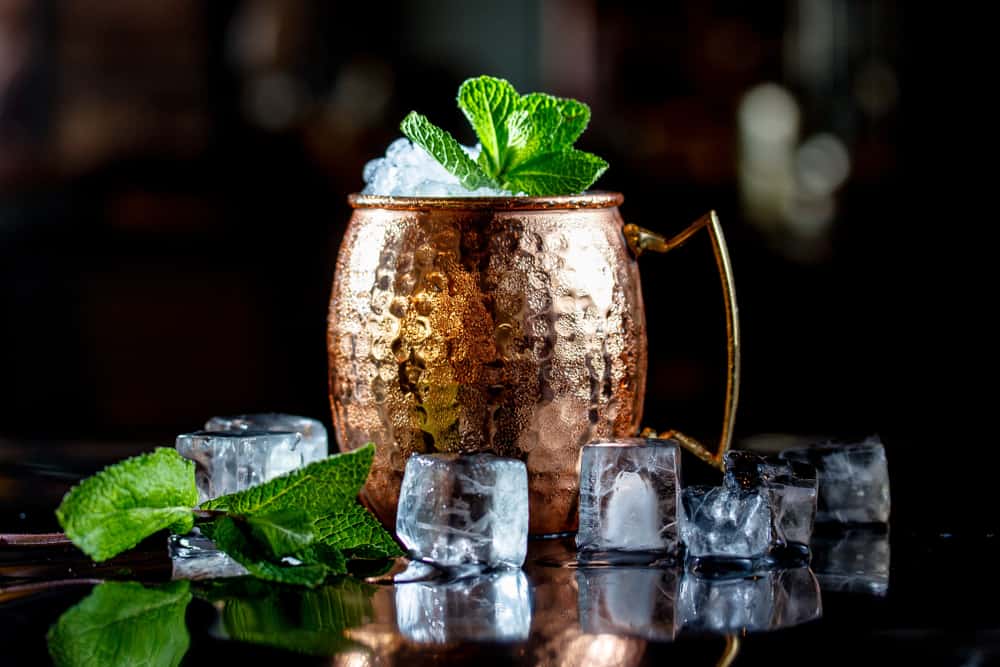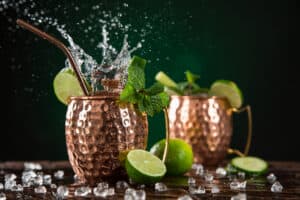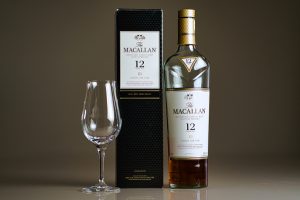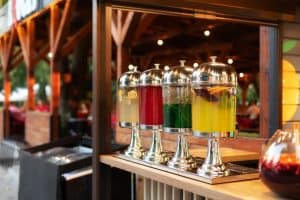
The Moscow Mule has pretty much nothing to do with Moscow, Russia, or mules. Besides, it’s served ice cold like a winter’s night, as you may expect to find in Moscow.
The cocktail is vodka-based—with citrus, spice, and subtle bubbles complimenting the strong, briny vodka taste. This may leave you wondering, what does a Moscow Mule taste like?
Comprising vodka, lime juice, and ginger beer, it tastes like a good time—a balance between fiery ginger, freshly-squeezed sour lime juice, and strong vodka. Served with the lime in a copper mug with the stirring rod, it is both refreshingly crisp and fizzy.
We will look at the history of the Moscow Mule, discuss the four elements that make up a Moscow Mule and see how all these elements add to the taste.
A Brief History of the Moscow Mule

The Moscow Mule was not born in Moscow, Russia; instead, it’s an American cocktail.
It’s claimed that Moscow Mule was mixed for the first time in Los Angeles, California at the Cock‘n’Bull bar back in 1941.
There are two origin stories for the cocktail. Bartender, Wes Price, claims he invented the recipe to use the over-stock of ginger beer in the bar’s basement.
Then, there’s the story of Cock‘n’Bull bar manager Jack Morgan and the Smirnoff executive, John Martin, who wanted to sell vodka to whiskey-loving Americans.
Moscow Mule finally put vodka on the map in America, along with the Bloody Mary. The first Moscow Mule was served to an actor Broderick Crawford. And the rest is history.
Any drink or cocktail made with ginger ale or ginger beer, citrus, and base liquor(s) is known as a buck, but they can also be called a mule.
Three Simple Ingredients Make One Amazing Cocktail
So, let’s look at the three key ingredients: freshly squeezed lime juice, ginger beer, and vodka.
Let’s deconstruct these flavors before we can reconstruct the flavor profile of a Moscow Mule.
Lime Juice

Lime brings a tart and sour taste.
Use the freshest limes you can find. Old and stale limes will unfortunately not do the trick. Limes contain higher levels of sugar and citric acid than their cousin lemons, but in a pinch, you could use lemons.
Avoid bottled lime juice at all costs because it lacks the characteristic strong flavor of fresh limes.
Ginger Beer

Ginger beer originated in England, where ginger, sugar, water, and sometimes lemon are brewed together with a starter culture ‘ginger beer plant,’ resulting in a beer with ±11% alcohol content.
Ginger beer can be alcoholic or non-alcoholic. However, most are made non-alcoholic today.
Use the best ginger beer you can afford, as this gives the Moscow Mule its characteristic spicy notes and flavor. Ginger beer fills the mouth with warm, spicy feelings and culminates in a warm feeling in the back of the throat.
If you are in a pinch, you can use ginger ale. Keep in mind that ginger ale is more carbonated than ginger beer, so it will have a lot more bubbles.
Sometimes straying from tradition and convention can be good!
Vodka

Vodka is perhaps one of the alcoholic spirits where price influences the taste. Opting for a cheaper vodka might not be immediately apparent as the lime and ginger beer mask it, but why settle for the bottom-shelf stuff when you want to treat yourself to a decent cocktail?
So, which style of vodka should I opt for? It all depends on your personal tastes.
I prefer traditional-style vodka from Eastern Europe (Poland, Russia, and the Baltic States) because of its robust and assertive stronger taste because distillers focus on the raw ingredients they use.
Western vodka, primarily from Europe and the United States, tends to be softer, more approachable, purer, and neutral. These lines are, however, blurring.
Traditional style Eastern European distillers opt for more smooth and neutral tastes, while Western European distillers go for a more pronounced flavor.
In short, try a few vodkas to see where your taste and palate lies. Make it a journey of discovery. Be bold and order a vodka tasting kit; from there, you can discover your favorite, order a case, and have your own supply.
If you’re still unsure which vodka to go for, here is a rundown of the best vodkas to make the best Moscow Mule.
The Copper Mug

Moscow Mule is typically served in a copper mug. Copper is an excellent conductor, and while it may not make you drink colder, your cocktail will seem colder.
If you do not have a copper mug, opt for a highball glass. One caveat, there is an FDA warning—acidity in the lime juice may cause uncoated copper to leach into your drink. Rather be safe than sorry!
Takeaway
So, what does a Moscow Mule taste like?
The combination of sour lime, slightly sweet but spicy ginger beer, and either smooth or robust vodka leave you with a satisfying thirst-quenching drink on a hot day.
The Moscow Mule also tastes festive because of the ginger spice. Don’t be afraid to mix some up during the Holidays. In a shot glass, it is a slightly sour and spicy cocktail with a good alcoholic kick.
Cheers!









